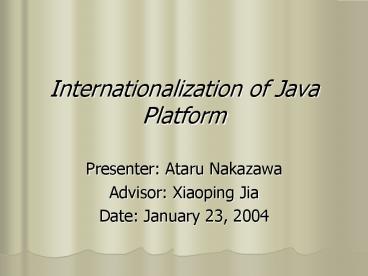Internationalization of Java Platform - PowerPoint PPT Presentation
1 / 16
Title:
Internationalization of Java Platform
Description:
Messages (e.g. English, Italian, Spanish and Japanese) ... UnicodeBlock classes need updating to provide access to the new characters and blocks. ... – PowerPoint PPT presentation
Number of Views:119
Avg rating:3.0/5.0
Title: Internationalization of Java Platform
1
Internationalization of Java Platform
- Presenter Ataru Nakazawa
- Advisor Xiaoping Jia
- Date January 23, 2004
2
Overview
- Introduction
- Issues
- Unicode 4.0
- Research Design
- Problem and challenge
- Work Plan
- References
3
Introduction
- How many countries are in the world?
- How many languages are in the world?
- How many people are in the world?
4
Answers
- How many countries are in the world?
- 192 countries (U.S. Department of State)
- How many languages are in the world?
- It is difficult to give an exact figure of
the number of languages that exist in the world.
According to Ethnologue, it is usually
estimated between 3,000 and 8,000. - How many people are in the world?
- 6,328,406,644 (U.S census Bureau)
5
What is Internationalization?
- Internationalization is the process of
designing an application so that it can be
adapted to various languages and regions without
engineering changes. - i18n
6
What is Localization?
- Localization is the process of adapting
software for a specific region or language by
adding locale-specific components and translating
text. - l10n
- Example
l10n
Buongiorno (Italian)
Hello (English)
7
Issues(Culturally Dependent Data)
- Messages (e.g. English, Italian, Spanish and
Japanese) - Dates (e.g. November/14/2003, 14 / 11 /2003)
- Times
- Numbers
- Currencies (e.g. , , , )
- Measurements (e.g. length, weight, capacity,
temperature) - Phone numbers
- Postal addresses
- Labels on GUI components
8
Issues that has been solved
- Locale
- Formatting Messages
- Character Sets and Unicode
- Collation
- Fonts
- Graphical User Interfaces
- Input Methods
9
Issues that has not been solved
- Unicode 4.0 Support
- Complex Text Enhancement
- Character Converter Framework
- Input Method Framework
- My research is going to be the Unicode 4.0
support in Java
10
Unicode 4.0 support in Java
- Currently, Unicode standard version 4.0 and Java
2 Standard Edition 1.4.2 are released (As of
January 5 , 2004). But the J2SE1.4.2 supports
only Unicode 3.0. The Unicode 4.0 is not being
supported by the J2SE 1.4.2. - Java 1.5 is going to be released in this coming
summer of 2004. It is going to support Unicode
3.1 but Unicode 4.0.
11
Unsupported Unicode Blocks
- 47,188 new character assignments were made to
the Unicode standard version 4.0 - from version 3.0.
- 38 unsupported Unicode blocks.
- http//students.depaul.edu/anakazaw/se690/Unsupp
ortedUnicodeBlocks.txt
12
Research Design
- The java.lang.Character and java.lang.Character.
UnicodeBlock classes need updating to provide
access to the new characters and blocks. - The normalization algorithm, used by the Collator
object, needs modification so that collation and
string comparison are carried out correctly. - The case mapping rules used to perform case
mappings between upper and lower case letters
need upgrading to handle new characters. - The character encoding converters need
modification to support these new characters.
13
Problem and Challenge
- 32 bits character assignments were made since
Unicode 4.0. That is why supporting the new
Unicode characters that are bigger than 16 bits
would be the hardest part.
14
Work Plan
- Design
- January, February, March
- Testing
- April
15
References
- http//java.sun.com, Java Tutorial, Sun
Microsystems, 2004. - http//www.oreilly.com, Java Internationalization,
O'Reilly, 2001. - http//www.unicode.org, Unicode Standard Version
4.0, Unicode Inc, 2003. - http//java.sun.com, Java Internationalization
Forum.
16
- E n d































